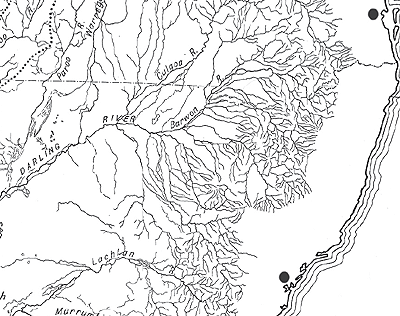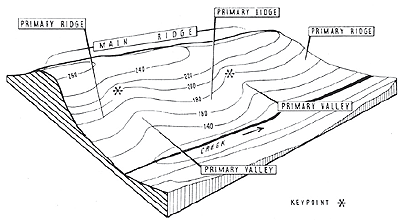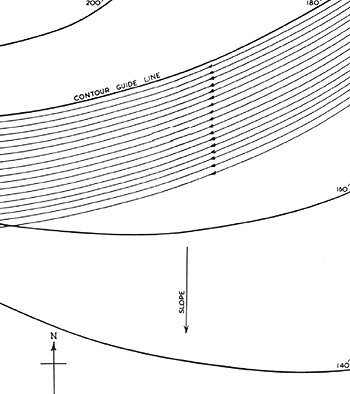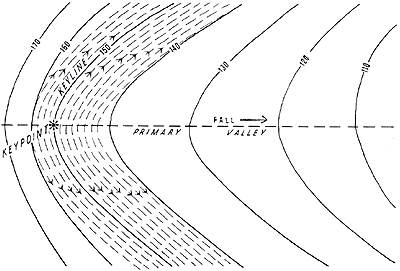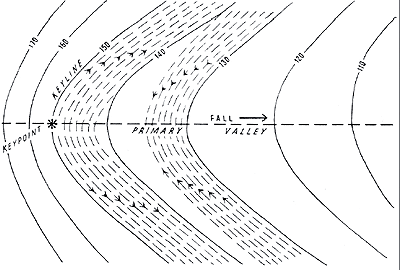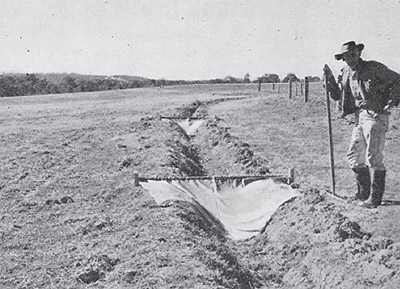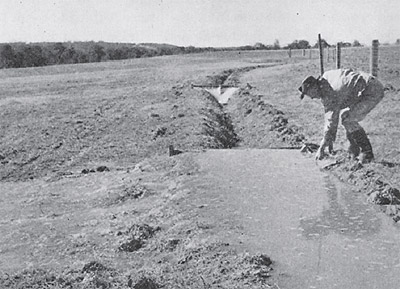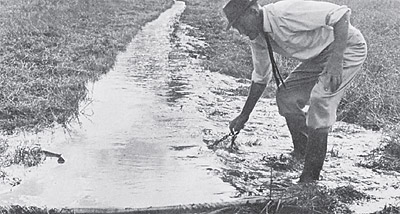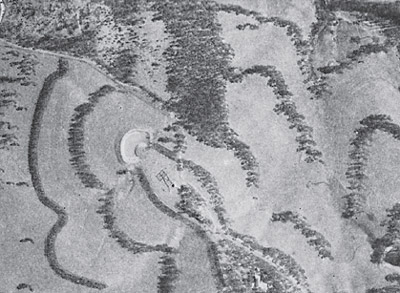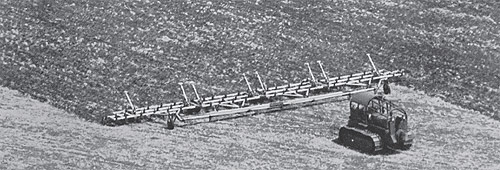1
1
2
2
3
3
4
4
5
5
6
6
7
7
8
8
9
9
10
10
11
11
12
12
13
13
14
14
15
15
16
16
17
17
18
18
19
19
20
20
21
21
22
22
23
23
24
|
THE KEYLINE SYSTEM HAS CHANGED ONLY SLIGHTLY FROM
THE ORIGINAL BOOKS BY P.A. YEOMANS. THIS EXPLAINS CURRENT
THINKING. Keyline planning is based on the natural topography of
the land. It uses the form and shape of the land to determine
the layout and position of farm dams, irrigation areas,
roads, fences, farm buildings and tree lines. Keyline
topographical concepts are often taught in university
town planning courses.
Keyline is an agricultural system in which great emphasis
is placed on processes designed to increase substantially
the fertility of soils. Emphasis is placed on the creation
of a soil environment that rapidly accelerates soil biological
activity, thus vastly increasing the total organic matter
content within the soil.
Keyline lay-outs of farm and grazing lands also incorporate
designs permitting the storage of run-off water on the
farm itself. This effectively spreads the often irregular
rainfall patterns so common to Australia, and in consequence
enhances rural production.
Keyline lay-outs and practices are designed and predicated
to the concept that farming systems that improve the fertility
of soils, and food production from these soils, must be
profitable to the man who farms the land.
Keyline concepts are totally against the current artificial
and dangerous practice of concentrating run off water
into manufactured disposal drains designed to remove,
as rapidly as possible, run-off water off a rural landscape.
The rapid evacuation of rainwater to the nearest ocean,
in this, the driest of the world’s continents is particularly
illogical. In addition, this practice can and often does
create more disastrous erosion than it was ever expected
to cure.
Keyline considers as totally erroneous the belief that
soil creation is an infinitely slow process and soil once
“lost” is lost forever. In fact soil fertility,
and even soil itself can often be created faster than
it can be eroded.
Keyline practices, once implemented, effectively eliminate
soil erosion, even as a possibility. The battle against
soil erosion and the concept of “soil conservation”
as a significant issue becomes totally meaningless.
The name Keyline was given to the particular contour
that runs through the point, in all small headwater valleys
where the slope change occurs. This contour is the primary
contour in Keyline planning. Among other things it delineates
the transition contour for cultivation, above which all
“contour” cultivation must proceed up the slope,
and below which all “contour” cultivation must proceed
down the slope.
The result of such “Keyline Pattern” cultivation
is that an overall drift of surface runoff water occurs
which prevents runoff concentration and the resultant
gutter erosion from occurring. It increases the time of
contact between the rain and the earth. It has the effect
of turning storms into steady soaking rain.
The Keyline contour need not be on the individual farm.
It is only necessary to know whether the contour to be
paralleled is above, or below a relevant Keyline. In this
way “drift” in either direction can be determined
and implemented. Paralleling up, or paralleling down from
a contour can direct the drift of rainwater away from
erosion sensitive valley floors.
The inversion of soil layers is quite contrary to Keyline
concepts and in fact contrary to almost every type of
soil fertility building practices anywhere in the world.
All cultivation, in fertility enhancing agriculture is
best done using an adaptation of the “forked stick”
plough of ancient times. Our own original cultivation
experiments used a variety of earth moving rippers until
we discovered the Texas built Graham Hoehme Chisel Plow.
We redesigned the old Graham Hoehme Chisel Plow to suit
the more extreme conditions usually found in Australia.
The plough was developed and promoted. The acceptance
and almost universal adoption of chisel ploughs has been
one of the most beneficial and noticeable changes in Australian
agriculture this last century.
We found over time that the chisel plow required more
fundamental refinements. It was good but it was still
not the ideal implement for rapid soil development type
agriculture. It was virtually incapable of one-go deep
tillage without excessive soil profile disturbance. The
current Yeomans Plow thus evolved. And the modern subsoil
plough was born. These implements achieve virtually the
ultimate in Keyline cultivation requirements. They are
able to operate well into the subsoil without the usual,
dilution by mixing, of the shallow topsoil with the huge
bulk of infertile subsoil underlaying it. The concept
of the narrow tine subsoiler we developed is now receiving
wide spread acceptance by both farmers and other manufactures.
This new plough has allowed for much accelerated Keyline
soil development progression by eliminating the need for
the time consuming, yearly increase in cultivating depth
necessary with the chisel plow
Keyline layouts for rainwater collection, storage and
irrigation has many advocates especially following the
experiments on Keyline techniques by Sydney University
and promoted as “water harvesting”. The universities
lack in not also realising the importance of fertile soil,
as a most economical water storage medium, limited the
worth of their studies, and to some extent also restricted
its acceptance.
The refinement of Keyline techniques following P.A. Yeomans’
the original books has seen a greater emphasis on determining
the most economical planning sequences for larger water
storage sites, and even more rapid fertility build ups.
Larger farm dams have tended to prove more viable.
A development program and layout for a property, with
a sequence of operations based on relative economic viability
of the individual stages, and including the location of
tree lines, road ways, water storage dams, fence lines
and houses is now easy and so totally logical. It is now
a simple matter to determine a complete farm or property
design, often in a matter of a few hours
While Keyline designs are based on the topography and
geology of the land, individual properties, unfortunately,
are shaped by an historic location of survey lines, and
such lines generally bear no relationship whatsoever to
topographical land forms. In consequence idealised Keyline
systems are usually hampered a little by the restraints
of farm boundaries. A major requirement of Keyline designs
is then to utilise the landform and topography, within
the restraints imposed by these boundaries. But that’s
easy.
Co-operation between farmers to their mutual benefit would
eliminate these design restraints and make for huge economic
savings and create viability for water harvesting and storage
systems that otherwise, just possibly, could not exist.
This coupled with correct cultivation and soil development
techniques to enhance biological activity would more rapidly,
vastly increase the fertility of all our soils, to all our
benefit.
|
|
|
The
following information is taken from:
PRIORITY ONE Together We Can Beat Global Warming
by Allan J. Yeomans 2005
|
|
Keyline
planning is based on the natural topography of the land
and its rainfall. It uses the form and shape of the land
to determine a farm ’s total layout. The topography
of the land, when viewed in the light of Keyline concepts,
clearly delineates the logical position of on-farm dams,
irrigation areas,roads,fences and farm buildings. It also
determines the location of tree belts to provide shade and
give wind protection. Keyline concepts also include processes
for rapid soil enrichment. The shape of a landscape is produced
by the weathering of geological formations over millennia.
The processes are always the same. And so the topography
of agricultural land has a basic fundamental consistency.
It is the inevitable nature of land shape that river valleys
collect water from smaller creek valleys. They in turn are
fed their water from still smaller valleys, until finally
the water derives from the very first, or primary
valleys of the catchment area. In any country,anywhere,when
rain shapes the land over long periods of time, it inevitably
creates and determines the topography of that land. Ultimately,
at the extreme upstream of any river system there always
exists thousands of primary valleys. The only variation
to consistent topographical shapes occurs where geological
features, such as hard rock outcrops modify normal surface
weathering.
|
|
|
|
At
the end of all these branches, sub-branches an sub-sub branches
are thousand of even smaller valleys that are the primary
valleys so important in Keyline planning. The map is of
northeast New South Wales and southeast Queensland and shows
part of the catchment areas of the east Australian inland
rivers system.
|
|
|
A contour
is a line meandering over the ground, always at the same
height above sea level.The name Keyline was given to a single,
very unique contour that occurs in all primary valleys.
As you walk up the watercourse in a primary valley, the
slope of the valley floor will suddenly increase.
That point of sudden steepening is the “Keypoint ”
of the valley. A contour line surveyed to run through this
Keypoint becomes the Keyline contour for that valley. Because
of the consistency in water-formed topographical land shapes
there is always a Keyline. The Keyline is always the primary
contour and guideline that tells us which way to cultivate
when attempting contour cultivation. It is also a logical
starting point for any farm layout planning,and supplies
a fundamental principle on which modifications to
existing layouts can be based. In planning the layout of
a farm or ranch it is often the case that no other contour
lines on the property need be surveyed and pegged, just
the Keylines for each primary valley. Keyline contour surveying
expenses therefore are always minimal. Normally when any
conventional contour ploughing is undertaken,a contour line
is first pegged or otherwise marked on the ground,
then ploughing commenced. Cultivation runs are made somewhere
between the valley centre line and the adjacent ridge. The
first furrow is ploughed adjacent to, and parallel
to the marked contour line. The second run is of course
adjacent to the first and so on. Let ’s say,
for illustration that each run is ploughed below the previous
run, as in the diagram on page 134. Because of the natural
topography of rain formed land shapes,cultivation runs soon
and inevitably depart from the original and accurately marked
contour. This always happens and usually after only a few
parallel runs.
|
|
|
|
This
diagram indicates the terms used in describing Keyline concepts.
Contour intervals are drawn in from the 130-foot line to
the 260-foot line.
|
|
In conventional
contour cultivation this effect is never appreciated and,
more often than not, is seen as an apparently unexplainable
irritation. Or it ’s ignored and invariably to the
detriment of the land. Because of this off-contour drift,
water flow can be directed the wrong way and contour
cultivation then creates the very erosion problems it is
supposed to solve. Keyline cultivation centres on the planned
and logical use of this “off-contour ” cultivation
and water drift phenomenon. In the illustration the length
of the guide contour shown might be a few hundred yards
long and the picture represents an area on the side of a
primary valley. The slope of the land surface is always
a little steeper at one end of this line than at the other
end. This difference is important in understanding Keyline
cultivation. In the illustration, when ploughing by paralleling
the guide contour and then progressively progressing down
the slope, each successive cultivation run will be slightly
lower at the steeper end of the paddock. This follows as
each pass with the cultivator will always have the same
width, but across each width the vertical height will be
slightly different. Inevitably, after just a few passes,
the ploughed furrows will no longer be on a true contour.
They will now have a de finite fall one-way or the
other, in this case to the left. Rain run-off will therefore
tend to have a positive flow, or drift along the now
slightly descending furrows. Now, if on the other hand the
ploughing starts parallel to the true contour but this time
ploughing progresses up the slope, then each successive
cultivation run will be slightly higher at the steeper end
of the cultivation area. Again the individual cultivation
runs will no longer be true contours. The drift of rain
or irrigation water run-off will be reversed. The water
will move to the right. It ’s logical to delay the
concentration and velocity of rainwater wherever possible
so it makes sense to give water a bias to move out form
the valley centre and not into it. Such drifts dramatically
minimize the all too common rapid concentration of rainwater
in valleys. The hundreds of furrows in Keyline pattern cultivation
spread the water and inhibit concentrations. In total contrast
the contour banks or drains advocated by standard soil conservation
practices are designed to rapidly concentrate water into
a valley, which naturally increases its eroding action.
Understanding this fundamental concept gives us control
of rainwater drift and flow over the land surface.
Of course if an area, for some extraneous reason is always
too wet, reversing the sequence of cultivation will dry
it out. The Keyline contour is extremely important in contour
cultivation. Above this unique contour the valley is steeper
than the adjoining ridge. Below
|
|
|
|
Illustrating
how cultivating parallel to a contour line inevitably forces
succeeding ploughed furors away from being true contours.
|
|
|
the Keyline
the valley is flatter than the adjacent ridge. Thus
cultivating parallel to the Keyline contour and moving up
the slope drifts water out of the valley and cultivating
parallel to the Keyline contour and moving down the slope
also drifts water out of the valley. If this phenomenon
is not recognized, what is supposedly contour cultivation
can manufacture the erosion that contour cultivation is
traditionally believed to prevent. This subtle but critical
feature occurring in all natural landforms determines surface
water movement and this must be appreciated before attempting
contour ploughing. The Keyline contour is thus the “transition
” contour. Above the Keyline, contour cultivation
runs must progress up the slope. Below the Keyline, contour
cultivation runs must progress down the slope. The result
of such Keyline Pattern cultivation is that the overall
drift of surface run- off water tends to always drift run-off
away from the wet valley floor and out onto the dryer
ridge. Erosion caused by rainwater flow is effectively
eliminated. Normally most water erosion occurs down the
centre line of a valley and results from
|
|
|
|
|
|
The
solid lines are true contours. The dashed lines depict parallel
cultivation furors.
The diagram above left shows a primary valley and its Keypoint
along with its associated Keyline.
Cultivation has proceeded from the Keyline up the slope
and also from the Keyline down the slope. Both drift the
run-off rainwater away from the valley floor. Above
the Keyline cultivation must always start at a true contour
and parallel up the slope. Below the Keyline cultivation
must always start at a true contour and parallel down the
slope. In other words all cultivation runs must always parallel
away from the valley’s Keyline.
In the diagram above right the upper cultivation is correct
and is proceeding away from the Keyline. But note how in
the lower cultivation area the runs are starting at the
130-foot contour and proceeding towards the Keyline thus
forcing runoff to concentrate into the valley centre.
|
|
|
the excess
concentration in water volume and water speed that normally
occur there. Keyline pattern cultivation spreads the flow
out over a wide area, rendering it harmless. It also markedly
increases the time of contact between the rainwater and
the soil. Water has more time to be absorbed. Keyline pattern
cultivation has the effect of allowing heavy storm rains
to be absorbed more easily into the earth. Generally such
absorption only ever happens with steady soaking rain. Keylines
in adjacent primary valleys are always slightly lower as
you proceed down the main valley or watercourse linking
the primary valleys. The location of farm dams or ponds
are decided by using that valley ’s Keyline to determine
the highest water level for the proposed dam. A Keyline
contour drain can then collect any run-off and help fill
the dam. Because of the drop in height of successive Keylines,
an outlet pipe through a dam wall will generally approximate
the level of the Keyline in the next valley downstream.
Generally, with very minor adjustments in levels, dam sites
can be logically linked so each Keyline dam can feed, via
a contour channel, to the next lower dam. These contour
drains are can be the same as conventional soil conservation
drains but must be almost flat to prevent the erosion
soil conservation drains can cause. A fall of 1 in 500 or
even 1 in 1, 000 is usually plenty. Installing a big outlet
pipe is wise when constructing a farm dam as this gives
absolute control of the system and pumping becomes unnecessary.
Everything is done by gravity. The design of farm dams,
constructed with large irrigation pipes a foot or more in
diameter, buried under the dam wall and fitted with
valves, and farm dams that can be filled or emptied
by contour drains, is a Keyline concept. It is a concept
my father borrowed from his experience in gold mining and
gold washing in Australia and New Guinea. In gold mining,
water often has to be transported for miles, usually through
dif ficult country and it must be done cheaply. In
gold mining, even more so than in farming, water itself
is gold. Water ’s collection, storage and cost are
of critical importance. The placement of dams with their
feeder and delivery channels
|
|
|
|
An
irrigation drain with two flags in position in readiness
to hold back and over flow the water stream
|
|
|
|
Canvas
wall being used to flood irrigate hill side land after
previous Keyline pattern cultivation. The water, released
by the valve in the back of the dam wall, moving along the
drain under gravity has reached the first flag,
filled it, and just commenced to flow over the
lip of the drain to irrigate the land below. The fence in
the picture is constructed to form the upper limit of the
irrigation paddock.P.A.Yeomans demonstrates his system.
|
|
|
determined
by the relevant Keyline contour is the logical adaptation
of old mining water handling techniques to agriculture.
I once found an old contour earth drain, miles long, in
the hills near the town of San Andreas in California. It
must have been hand built by some of the “forty-niners
”to wash gold from their claim. To me it looked exactly
like a Keyline drain on my father ’s farms. As sometimes
can happen, storm rains occur when farm dams are already
full. But that ’s O. K. as the Keyline cultivation
patterns in the valleys effectively spread the width of
the moving floodwater and so decrease its velocity.
The valleys become covered with a wide sheet of slowly moving
water. Even in steep country the land won ’t erode.
Keyline ’s cheap ef ficient dam construction
and water transport systems mean that increasing grass and
crop production by irrigating from the on-farm water storage
ponds can vastly accelerate soil fertility development.
To irrigate using the Keyline systems the pipe through the
dam wall is turned on, flooding the Keyline channel
to the next dam. This channel can then be blocked with a
pegged down sheet of canvas (called a “flag
”)forcing the water to over flow the channel
and flood down the slope.
|
|
|
|
Aerial
photo of the trees on Nevallan.Using Keyline design principals
either land is cleared, or on cleared land trees are planted,
to form both windbreaks and shaded areas for livestock.
Trees are ultimately harvested and the tree belts replanted.
|
|
The patterned
cultivation spreads the water with ample consistency. The
canvas wall is then moved further along the feeder channel
to a new location and the process is repeated. Each move
takes just a few minutes. In very flat land a slightly
different system is used. Either way a person can comfortably
irrigate and control water flow rates easily exceeding
one acre-foot per hour (one mega litre per hour). The per-acre
cost of irrigation equates to simply interest cost on the
capital to create the dams and the contour channels, plus
the few minutes required for each move. There is no cheaper
form of irrigation. Keyline principles are totally against
the concept of concentrating run-off water into manufactured
disposal drains that are speci fically designed to
remove rainwater off the farm as rapidly as possible. Yet
the supposedly safe rapid removal of water off a farm is
the basis of all current soil conservation principles. In
Australia, the driest of the world ’s continents,
such advocacy is almost criminal. Using Keyline design principals
either land is cleared, or on cleared land trees are planted,
to form both windbreaks and shaded areas for livestock.
Trees are ultimately harvested and the tree belts replanted.
The other major facet of the Keyline system involves the
soil itself. Keyline uses concepts of rapid and economical
soil fertility enhancement. As Keyline developed it became
obvious that rapid increases in soil fertility from the
substantial increase in soil biological activity, could
and should be an underlying fundamental of all farming endeavours.
The soil in Keyline philosophy is never cultivated by turning
the earth upside down. Cultivation is only undertaken using
modern versions of the forked stick of ancient agricultural
practices. The Graham Chisel Plow was used for years for
Keyline soil development until we developed, in the 1970s
an ef ficient and practical implement, capable of
effective subsoiling as well as ful filling the role
of a chisel plow. This implement reached deeper into the
soil than a chisel plough but with considerable less soil
pro file disturbance. The resulting improvement in
soil fertility, with either implement not only increases
crop yields and food production, but also simultaneously
reduces costs. Additionally, less water is required if irrigation.
For more on subsoiling see EXTRA:THE FORKED STICK AND
THE SUBSOIL PLOUGH in PRIORITY ONE Chapter 8. Soil is
never homogeneous even if it appears so. In any soil, individual
bits randomly clump together and form crumbs or aggregates.
The better the soil, the greater the quantity and mass of
aggregates within the soil. The bits in the aggregates tend
to hold together much more tightly than the assembled aggregates
hold to each other. The degree of aggregation de fines
“soil structure ”. Soil aggregates however,
can easily be broken up and destroyed by tumbling in a cement
mixer. Either wet or dry, the aggregates break up. Excessive
soil cultivation has the same effect. Land is sometimes
cultivated several times to produce a “fine
seed bed ”in which to sow. This is a mistake. It is
a harmful practice and is being abandoned. Edible crop seeds
germinate within soils when humidity levels are high and
air is available, not in water saturated soil. However,
in any crop preparation prior to planting, at least one
cultivation is required, both to loosen compacted soil and
act as a weed killing operation. The much-publicized arguments
promoting the concept of “minimum tillage ”is
primarily an argument that the weed killing cultivation
should be abandoned and herbicides be used to control weeds.
In the so-called “zero tillage ”concept, crops
are supposedly to be grown using only seed and chemicals.
Many farmers have tried zero tillage but found (as one might
expect)it doesn ’t work. The shape and the size of
the aggregates in soil vary considerably. They are typically
the size of very small pebbles. The spaces between the aggregates
(called pores)can fill up with air and water. If the
aggregates hold together well and resist crushing, and have
a good general shape so that the pores form nice little
connecting channels, then the soil is said to have a good
“structure ”. The tiny fibrous roots of
plants and grasses love to meander down through the maze
of passages in a well-structured soil, hunting for nutrients.
All those little pores and channels have the ability to
hold water. The volume held is termed the “field
capacity ”. Field capacity is de fined as the
measure of a soil ’s capacity to retain water for
plant use. Retention is a critical factor so field
capacity is usually considered as the volume of water retained
in the soil a couple of days after heavy soaking rain. It
is what is retained after excess water has had time to drain
away. Field capacity determines how long soil life can function
and operate ef ficiently before another rain shower
becomes essential. Rich, humus-laden soil has excellent
field capacity. Poor soil has very little. Sand has
almost none. Organic farming and Keyline farming practices
massively increase field capacity, thereby decreasing
rainfall and irrigation requirements. To initiate the soil
building process in Keyline (and in any natural fertility
enhancing process), it is first necessary to grow
a “crop ”of almost any form of vegetation. That
crop dies, drops litter, or sheds root matter, which in
turn decomposes to become soil organic matter and ultimately
stable humic acid. The crop need not necessarily have accepted
commercial value. It only needs to be voluminous and readily
decomposable. The use of limited quantities of chemical
fertilizers, such as lime or superphosphate, to stimulate
the volume or mass of that initial crop is, unlike strict
organic farming mandates, perfectly acceptable in Keyline
development, but only in the first year. After that,
chemical fertilizers must be avoided to ensure a rapid increase
in active soil life. It is acknowledged that ef ficient
biological soil development processes are impossible with
continuing high chemical use. If not constituting the first
crop, then grasses and legumes should be utilized in the
second growth phase. This second crop has de finite
commercial value. It can be eaten off periodically, or it
can be regularly forage harvested. Keyline concepts beginning
in the early 1950s have consistently advocated the overstocking
of con fined grazing areas for short periods such
as a few days, then moving the stock animals onto a new
area to produce a constantly decomposing mass of root matter.
This procedure is discussed in Chapter 8: HOW WE CREATE
FERTILE SOIL TO STOP GLOBAL WARMING. This same procedure
has just recently been adopted and promoted as “cell
grazing ” or “rotational grazing ”by the
new “holistic ” agricultural consultants. Cell
grazing concepts however, form only part of the broader
concepts of soil fertility enhancement. The development
and enrichment of fertile soil are processes that have been
known for centuries. Keyline soil enrichment systems merely
streamline the process. Organic farmers are usually familiar
with the general techniques. In Keyline the soil building
process is accelerated by subsoiling with an implement that
guarantees minimum soil layer disturbance. This is then
coupled with rotational grazing and, ideally, with low cost
irrigation. The objective in Keyline is to always make the
creation of healthy fertile soil a pro fitable endeavour
for the farmer. There are several facets of Keyline. Over
the years since its inception many have been adopted singularly
and have proved pro fitable even in isolation. Farmers
have adopted Keyline layouts for rainwater collection, storage,
and irrigation,
|
|
|
|
A
Graham Plow especially built for a Queensland farmer. It
was 69 feet wide,and believed to be the largest plow in
the world at the time (1955). (from THE CHALLENGE OF LANDSCAPE
.P,A. Yeomans 1958.)
|
|
|
especially
following the successful trials on Keyline techniques by
Sydney University at their McGarvie Smith Animal Husbandry
experimental farm at Badgery ’s Creek NSW in the 1960s.
The University very successfully promoted the Keyline concepts
as a form of “water harvesting ”. Although Badgery
’s Creek is in the same county as Yobarnie and Nevallan,
the soil types are not absolutely identical, but the University
found the bene fits indeed were. Here in Australia
I am often asked, “Have Keyline concepts been taken
up by many farmers?”. Yes they have. Over the last
fifty years I have seen Australian agriculture change
dramatically. Many of the facets of Keyline have now become
“conventional ”agriculture in this country.
We see Keyline concepts and philosophies adopted everywhere.
We see it in the establishment of tree belts, the design
and location of farm dams, the general use of contour drains,
not to supposedly prevent erosion, but to convey water to
and from farm dams and to flood irrigate from these
drains. We see it in the widespread adoption of non- inversion
tillage practices with the widespread use of chisel ploughs
and the heaver subsoiling ploughs developed from them. We
also see farmers minimizing or often eliminating their use
and reliance on agricultural chemicals. This change has
come despite considerable resistance by the Australian soil
conservation establishment to most of the concepts of Keyline
thinking. It is a marketing reality that big money talks.
In consequence, and by a variety of means, government agencies
everywhere are coerced by the agrochemical companies into
listening to and accepting almost as gospel, the promotional
material the companies produce. Most governments now accept
the fabricated concept that bene ficial agriculture
totally relies on and is dependent on, high chemical inputs.
Such indoctrination unfortunately prevents both the enrichment
of the world ’s soils and the entrapment of carbon
dioxide into them. In addition to their use in agriculture,
Keyline topographical concepts have been included in several
university architectural and town planning courses in Australia,
the concept being that the layout of large-scale subdivisions
and even whole towns could be planned based on the concepts.
Keyline concepts and designs are becoming increasingly widespread
as time goes by. Professor Stuart B. Hill, Ph. D. , who
holds the Foundation Chair of Social Ecology at the University
of Western Sydney, and Martin Mulligan, a lecturer in that
faculty, and who is also editor of the journal Ecopolitics:Thoughts
and Action, recently co-wrote an excellent Australian historical
book Ecological Pioneers . In discussing my father and the
concepts involved in Keyline designs, they say:- “Despite
its marginalisation by conventional agriculturists, Yeomans
’ approach to ecological design was, as mentioned
above, one of the main sources of inspiration for the development
of “Permaculture ”. The birth of this movement
dates back to 1972 when Bill Mollison –a psychology
lecturer and well-known “identity ”at the University
of Tasmania, and David Holmgren –a student in the
Environmental Design Course at the College of Advanced Education
in Hobart, began an unlikely but highly productive collaboration.
The extroverted Mollison has gone on to establish an international
reputation as the “father ”of Permaculture;
giving inadequate credit to Holmgren and virtually none
at all to Yeomans. Holmgren ’s story is certainly
less well known, but of great importance in tracing the
lineage of ideas that have manifested themselves in Permaculture
design practices. ” Keyline practices, once implemented,
effectively eliminate all soil erosion. The “battle
against soil erosion ”, the concept of “soil
conservation ”, and the costly bureaucratic industry
these buzzwords have created, become irrelevant and unnecessary.
Keyline, like classic organic farming, is a soil creation
system. It is not a soil conservation system at all. Soil
conservation is a negative term and implies merely delaying
some inevitable future situation where apparently all the
World ’s soil will be gone. The Keyline system as
originally conceived was not designed to produce organic
food, nor was it designed to assist the mitigation of Global
Warming. It was designed to develop poor land into good
land, and it was designed to make farming pro fitable
in the quickest most ef ficient way. To me, Keyline
became important in relation to Global Warming and organic
farming because it was a tenet of Keyline philosophy that
the best path to achieve its objectives was via the creation
of highly fertile soil. And fertile soil is humus-rich soil,
and forming humus consumes huge quantities of carbon dioxide.
Although Keyline concepts were never designed with the prevention
of Global Warming in mind, I believe that the widespread
adoption of Keyline principles is probably the most practical
and pro fitable change that agriculture should embrace
to achieve that worldwide imperative.
|
^
Back To Top ………………………………………………………………. yeomans-keyline-system.htm
|
|

